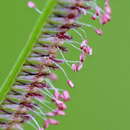Comprehensive Description
provided by North American Flora
Chloris petraea Sw. Prodr. 25. 1788
lAira aegilopsoides Walt. FI. Car. 78. 1788. (Type from South Carolina.)
Agroslis complanata Ait. Hort. Kew. 1: 96. 1789. (Type grown in England, seed from Jamaica.)
Eustachys petraea Dcsv. Nouv. Bull. See. Philom. 2: 189. 1810. (Based on Chloris petraea Sw.)
SchuUesia petraea Spreng. Pug. 2: 17. 1815. (Based on Chloris petraea Sw.)
Aira complanata Ait.; Steud. Nom. Bot. ed. 2. 1: 44, as synonvm of Chloris petraea Sw. 1840.
Chloris Swarlzii C. Miill. Bot. Zeit. 19: 341. 1861. (Based on C. petraea Sw.)
Chloris septentrionalis C. Miill. Bot. Zeit. 19: 340. 1861. (Type from Rio Brazos, Texas, Drum-
mond.) Chloris Swartziana Doll, in Mart. FI. Bras. 23; 68. 1878. (Based on C. petraea Sw.)
Perennial; culms erect or sometimes decumbent at the base and rooting at the lower nodes, 30 cm. to more than a meter tall, conspicuously flattened; sheaths broad, flattened and keeled, crowded at the base in a fan-shaped cluster; ligule very short, minutely ciliate; blades conduplicate at the base, becoming flat toward the obtuse tip, 4-20 cm. (mostly about 10 cm.) long, 4-8 mm. wide, glabrous or densely pubescent on the upper surface at the very base; spikes 2-7 (usually 4-6), 3-12 cm. (mostly 6-8 cm.) long, digitate, narrowly ascending; spikelets 2 mm. long, horizontally spreading; glumes l-nerved, scabrous on the keel, the first 1.2 mm. long, acute, crescent-shaped, the second a little longer, broader, obtuse, notched, with an awn 0.5-1 mm. long; fertile floret dark-brown, 1.8 mm. long, the callus very short and rounded, the lemma obovate, blunt, pubescent on the keel, sparsely short-hispid on the upper half of the margins, the tip scabrous, the internerves smooth and shining, awnless; rudiment oblongtruncate, about 1 mm. long, 0.5 mm. wide, the tip scabrous.
Type locality : Jamaica (Swariz) .
Distribution: Open sandy ground, usually near the coast, Southeastern United States, eastern Mexico, and the West Indies, and southward to Trinidad and Panama.
- bibliographic citation
- Albert Spear Hitchcock, Jason Richard Swallen, Agnes Chase. 1939. (POALES); POACEAE (pars). North American flora. vol 17(8). New York Botanical Garden, New York, NY
Physical Description
provided by USDA PLANTS text
Perennials, Terrestrial, not aquatic, Rhizomes present, Rhizome short and compact, stems close, Stolons or runners present, Stems nodes swollen or brittle, Stems erect or ascending, Stems geniculate, decumbent, or lax, sometimes rooting at nodes, Stems caespitose, tufted, or clustered, S tems terete, round in cross section, or polygonal, Stems compressed, flattened, or sulcate, Stem internodes hollow, Stems with inflorescence less than 1 m tall, Stems, culms, or scapes exceeding basal leaves, Leaves mostly basal, below middle of stem, Leaves mostly cauline, Leaves conspicuously 2-ranked, distichous, Leaves sheathing at base, Leaf sheath mostly open, or loose, Leaf sheath smooth, glabrous, Leaf sheath or blade keeled, Leaf sheath and blade differentiated, Leaf blades linear, Leaf blades 2-10 mm wide, Leaf blades mostly flat, Leaf blade margins folded, involute, or conduplicate, Leaf blades mostly glabrous, Leaf blades scabrous, roughened, or wrinkled, Ligule present, Ligule a fringed, ciliate, or lobed membrane, Inflorescence terminal, Inflorescence solitary, with 1 spike, fascicle, glomerule, head, or cluster per stem or culm, Inflorescence a panicle with narrowly racemose or spicate branches, Inflorescence a panicle with digitately arranged spicate branche s, Inflorescence with 2-10 branches, Inflorescence branches 1-sided, Lower panicle branches whorled, Inflorescence branches paired or digitate at a single node, Flowers bisexual, Spikelets pedicellate, Spikelets sessile or subsessile, Spikelets laterally compressed, Spikelet less than 3 mm wide, Spikelets with 2 florets, Spikelet with 1 fertile floret and 1-2 sterile florets, Spikelets solitary at rachis nodes, Spikelets all alike and fertille, Spikelets bisexual, Spikelets disarticulating above the glumes, glumes persistent, Spikelets secund, in rows on one side of rachis, Rachilla or pedicel glabrous, Glumes present, empty bracts, Glumes 2 clearly present, Glumes equal or subequal, Glumes shorter than adjacent lemma, Glume surface hairy, villous or pilose, Lemma similar in texture to glumes, Lemma 3 nerved, Lemma apex truncate, rounded, or obtuse, Lemma awnless, Lemma mucronate, very shortly beaked or awned, less than 1-2 mm, Lemma with 1 awn, Lemma awned from tip, Lemma m argins thin, lying flat, Lemma straight, Callus or base of lemma evidently hairy, Callus hairs shorter than lemma, Palea present, well developed, Palea membranous, hyaline, Palea about equal to lemma, Palea 2 nerved or 2 keeled, Palea keels winged, scabrous, or ciliate, Stamens 3, Styles 2-fid, deeply 2-branched, Stigmas 2, Fruit - caryopsis.

